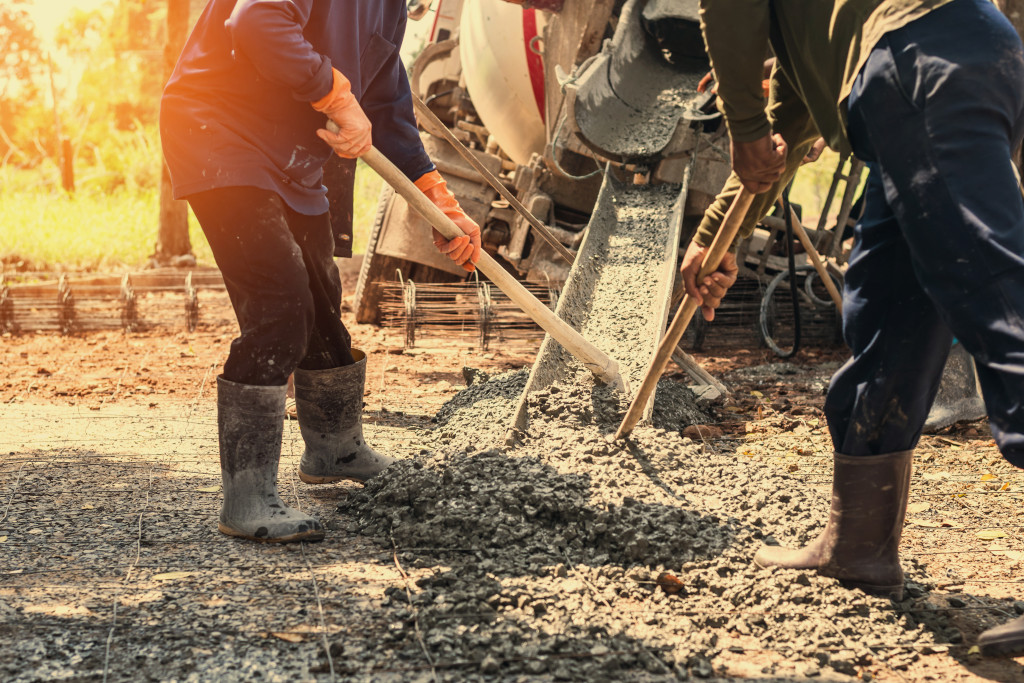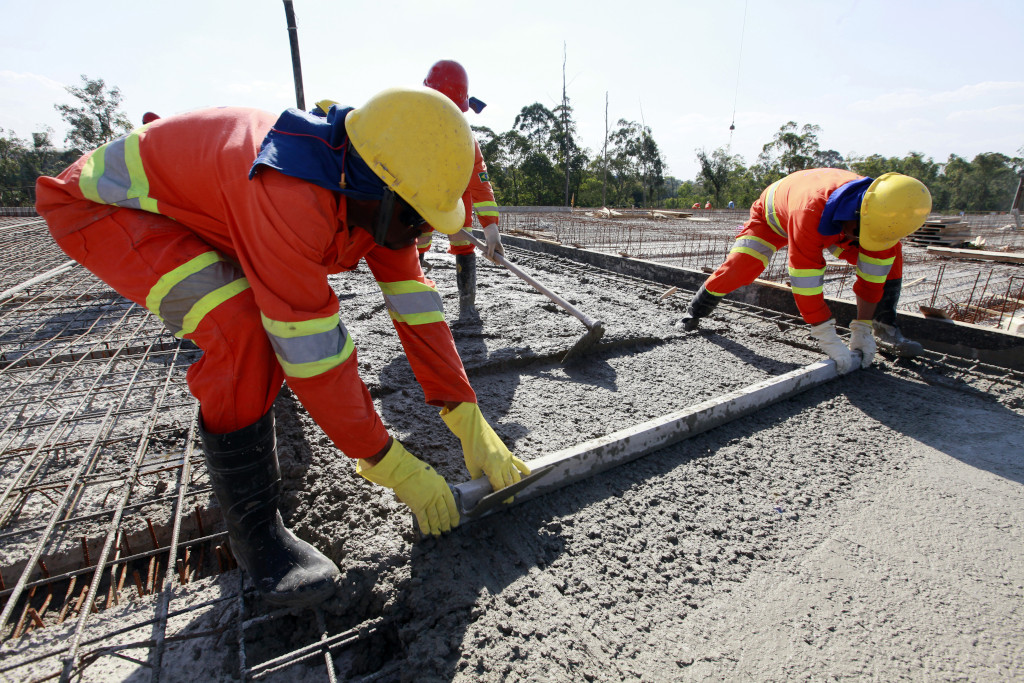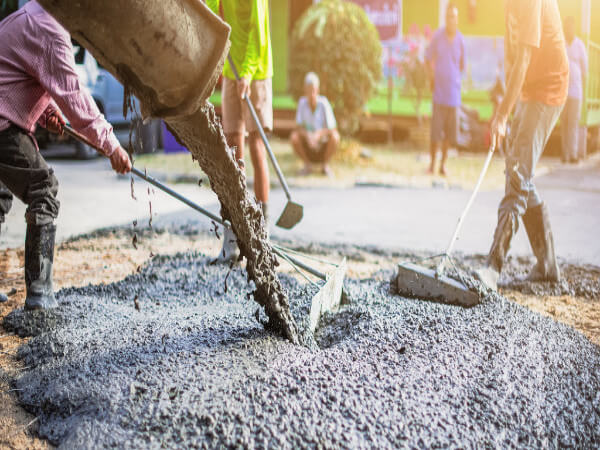No matter where you are in the construction industry, you want the structures you work with to last. After all, no one likes to hear that their work failed to live up to expectations. And the expectations for long-lived structures have only grown, increasing as the concern for sustainability and climate change rise. There’s also now more demand for environmentally friendly structures that can resist harsher climates. In short, now more than ever, you’re looking for ways to keep your structures standing for as long as possible and to help them survive the wear and tear of weather and everyday activity.
In your search for the right solution to this, you may have come across our integral hardening admixture, Hard-Cem. Known widely to be a great solution for warehouse durability (and more), it’s been applied to over 7 million m2 (80 million ft2) of concrete across Canada.
But what makes it so popular? And why should you consider it for your future projects? These frequently asked questions and more have been given a great deal of thought in a number of our other articles. But to make sure you get all your answers in one place, we’ve decided to respond to these questions in an easy-to-read guide here.
So, What Is Hard-Cem Exactly?
As we briefly touched on earlier, Hard-Cem is an integral hardening admixture meant to make concrete more durable against abrasion and erosion. In fact, it’s the only one of its kind on the market currently!
Other concrete hardening solutions typically come in the form of dry shakes, liquid hardeners, or other conventional forms. However, they can also come with application concerns.
For one, dry shake products usually have a complicated application process, so there is a higher risk of applying them incorrectly. And because these products often come with toxic silica dust, workers are more likely to get exposed to that material and develop health problems.
Liquid hardeners, on the other hand, while safer and less complicated to use, are just not that effective. They’re designed to reduce dust from weak, improperly finished or fast-drying concrete slabs. They aren’t and shouldn’t be expected to increase concrete hardness to prevent abrasion or erosion.
And both dry shakes and liquid hardeners require time-consuming manual labor, which often requires expensive equipment.
Hard-Cem, however, is free of all these concerns! Because it’s an admixture, it just needs to be added to your concrete mix. And that’s it! It only has one step, so there’s no risk of applying it incorrectly. Hard-Cem also does not expose workers to silica dust, so it helps make jobsites safer. As a result, with Hard-Cem, you get an easier and safer way to create concrete that is harder and better able to resist abrasive and erosive forces.
How Does It Help with Concrete Hardening?
To help with concrete hardening, Hard-Cem is first added into the concrete mix. From there, it disperses throughout the mix, allowing hard particles to get embedded into the cement paste, increasing the hardness of the entire concrete slab. In turn, the cement paste wears more slowly, which reduces material loss that would normally expose the underlying aggregates and make the slab uneven and less functional.
All of which helps double the wear life of the concrete and increase its resistance to abrasion and erosion. And that remains a permanent, life-long feature for the concrete as Hard-Cem becomes a fundamental part of the concrete mix.
Will It Increase Concrete Performance?
Outside of extending your concrete’s wear life and raising your concrete’s resistance to abrasion and erosion, Hard-Cem can also increase your concrete’s chipping resistance. In short, it increases your concrete’s performance in terms of durability against physical wear and tear.
In fact, Hard-Cem is capable of doing this for both regular concrete slabs and concrete joints! However, it’s important to note that if you’re expecting severe wear on your concrete joints to the point that joint-armoring technologies are required, Hard-Cem is not meant to be a replacement for that technology specifically.
How Does Hard-Cem Increase Concrete Durability without Increasing Cement Content?
The fact that Hard-Cem doesn’t increase cement content might seem surprising at first considering it’s common to increase the cement content of your concrete to boost its durability. But keep in mind that Hard-Cem is an additive that strengthens and reinforces cement paste.
A good example for how that works is to think of additives that can be used in tire manufacturing. You’re still using the same amount of rubber, but the tires themselves can be manufactured to be more durable and abrasion-resistant.
Hard-Cem works in a similar way. It’s acting directly in the cement paste to reduce the rate of wear loss. So even though the bulk concrete still has the same or similar compressive strength and properties with Hard-Cem, the addition of Hard-Cem will still help reduce the wear of concrete when it is subject to abrasive and erosive forces. And it does that without the need to add more Portland cement to your concrete mix, allowing you to strengthen it and maintain lower carbon emissions.
How Is It Added to the Concrete?
Hard-Cem is added right into a concrete truck at the batch plant through your local concrete provider. There are no extra steps, and it ensures Hard-Cem is properly added to your mix before you start pouring your concrete. Hard-Cem is available in easy-to-use mixer-ready bags or bulk silo deliveries for larger jobs.
What Projects Can It Be Used For?
It can be used in any project of yours that needs a strong resistance to abrasion and erosion. That typically applies to warehouses. But there are so many more worthwhile applications!
Other projects that often get the most benefit out of Hard-Cem include the following:
Industrial service and repair baysHighway pavements and intersectionsBridge decksRunwaysParking structures, ramps, and apronsSkate parksTunnelsShaftsProcess buildings for mining, oil, and gas industriesUtility and maintenance buildingsLivestock housingStorage shedsTractor garagesDamsSluiceways, spillways, and drainage conduitsStilling basinsCulverts and precast pipesCanalsBlocks and pavers
Is Hard-Cem Compatible with Supplementary Cementitious Materials?
Yes, Hard-Cem has been successfully applied in a number of projects that use supplementary cementitious materials (SCMs), such as fly ash, ground-granulated blast-furnace slag, and silica fume.
Is It Compatible with Air-Entrained Concrete?
Also, yes! Hard-Cem is fully compatible with air-entrained concrete. Hard-Cem is not harmful to the air-void system. And air-entrained concrete treated with Hard-Cem remains highly durable to freeze-thaw cycles and salt scaling.
Is There Anything It Isn’t Compatible With?
In general, Hard-Cem is a highly versatile admixture! In addition to being compatible with SCMs and air-entrained concrete, it can be used for a wide variety of concrete placements whether they’re horizontal, vertical, or inclined.
Even its application can be versatile. Hard-Cem works with ready-mix, shotcrete, and precast concrete applications.
And no matter what mix you use, which concrete placement you go with, or how you apply it, Hard-Cem will not negatively impact your concrete’s water demand, workability, set time, strength development, or shrinkage. Instead, you’ll get the same concrete but with better durability.
Does Hard-Cem Change the Concrete’s Finishing Properties?
No, Hard-Cem does not change the finishing characteristics. In fact, finishers report a high level of satisfaction when working with the admixture. Moreover, Hard-Cem can be used with any specified finish.
Do You Have Any Other Resources That Can Teach Me More about Hard-Cem?
If you still have some questions about Hard-Cem or just want to satisfy a more personal curiosity in our novel concrete hardener, we have plenty of digital resources just for you:
Articles“The Top 4 Types of Smart Concrete Technologies to Boost Concrete Construction”“A Study in Durable Design: Creating the Award-Winning Metro Skate Park”“Hard-Cem: It’s Not Just for Warehouse Floors”“Why Hard-Cem Shotcrete Should Be Your Solution for Durable Concrete”“Liquid Hardeners vs Hard-Cem: Which Is Better for Concrete Durability?”“Lower Your Concrete Carbon Footprint with These 4 Innovative Methods”“Silica Dust: The Dangers and How You Can Mitigate Them”“Convert Your Concrete Slab from a Maintenance Liability to an Asset”
Case StudiesVancouver Convention CentreBear Creek HydroBrandt Tractor Ltd. warehouseAn Abbotsford residential workshopAshbridges Bay Skate Park
Educational ContentWebinar on integral concrete hardening for wear-resistant concreteHanley Wood University’s course on our integral hardening admixture for wear-resistant concreteConstruction Canada’s demo-cast recording on Hard-Cem
If I’ve Already Decided to Add Hard-Cem to My Project, Where Would I Get It?
We offer Hard-Cem through concrete providers around the world. So if you’d like to add Hard-Cem to your project, get in touch with your local provider. You can also check out our website for a list of contacts who could help you with your Hard-Cem needs.

The post Concrete Hardening with Hard-Cem®: Frequently Asked Questions appeared first on Kryton.
Did you miss our previous article…
https://cedarparkconcrete.org/?p=281
































